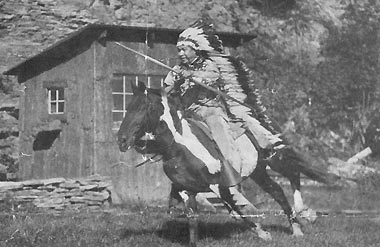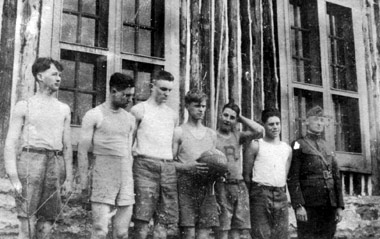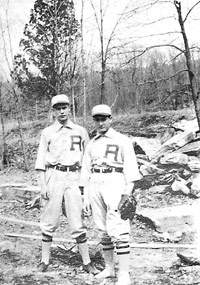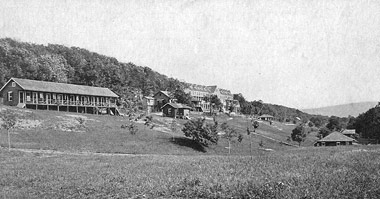The Riordon School
Spring 2009
 Archery is “taught by Chief Crazy Bull (Ta Tan Ka Witko)—grandson of the heroic warrior of the Sioux, Sitting Bull…” That’s from the opening paragraph of a four-page brochure, Authentic American Archeryproduced by The Raymond Riordon School, Highland, Ulster County, New York, informing prospects this won’t be education-as-usual.
Archery is “taught by Chief Crazy Bull (Ta Tan Ka Witko)—grandson of the heroic warrior of the Sioux, Sitting Bull…” That’s from the opening paragraph of a four-page brochure, Authentic American Archeryproduced by The Raymond Riordon School, Highland, Ulster County, New York, informing prospects this won’t be education-as-usual.
Ulster County has had a number of schools outside the sway of “public education” (the Socialist Labor School in Esopus comes to mind, and of more recent vintage the Benjamin Franklin School in Highland). Schools that neither taxed for support nor coerced attendance. Rather, these schools filled seats by appealing to the desire of the student, and more often, their parents. These schools competed with “free” government schooling by offering something more compelling than a one-size-fits-most education or world view.

Cover photo of Riordon School Archery brochure
As proof of that compelling blend provided at the Riordon School, nothing is more evocative than Bernard Sexton’s “Preface For The Boys’ School,” a lovely 1914, 46-page booklet printed by Roycroft Press, East Aurora, NY.
After a brief discussion of private European boarding schools for boys, Sexton opines that that form is not ideal for an American model.
…This I feel is a mistake, for an American school tradition must have its root in American soil. It must incorporate the forest and the plains tradition, the Mound Builders, the Indian, the Buckskin Man. I do not mean that the foreign tradition should be rejected because of a narrow provincialism. On the contrary it should be included but it should not be basic. The forests, fields, plains, rivers, mountains and lakes of America with their folklore, their tradition, their unique story should be the basis for the American school….
Sexton goes on to explain the vision of Riordon in forming his school in 1914. Writing on Riordon, he continues,
…He is no village philosopher. He believes in travel, in strange adventure, in knowledge of curious and useless things merely because they are charming and interesting. It is a sad sort of man who is always seeking the useful and Mr. Riordon is not a sad sort of man.
Sexton provides more of Riordon’s motivation for this “little school in the hills.”
 Mr Riordon has this feeling that knowledge is exciting. He is excited himself about his school, the country, the world. After all, life is a terrific adventure. None of us knows what Evolution has up its sleeve, but we will sharpen our wits and play the glorious game of life, and we will begin playing it in school.
Mr Riordon has this feeling that knowledge is exciting. He is excited himself about his school, the country, the world. After all, life is a terrific adventure. None of us knows what Evolution has up its sleeve, but we will sharpen our wits and play the glorious game of life, and we will begin playing it in school.
This different kind of education was often expensive. Another page of the handbook about The Riordon school tells us that tuition for the entire academic year (October-June), board, lodging, use of text books is $850. The school was open to all boys between nine and nineteen, provided they had a medical certificate from their physicians and passed the school’s own physical. It comforts parents by assuring them there is telephone service, local and long distance. The number is Highland 111.

Riordon School Basketball team played against other schools in Ulster County. Vernon “Pete” Petersen is holding the ball. His daughter lent us the photos.
Note rustic building and uniform on right side of photo. Photo circa 1919.
School lands consisted of 300 acres plus a 500 acre demonstration fruit farm. Farm & Camp sessions began July 1st.
Regular school year started October 1st.
The Riordon School shaped its fortunate young charges’ lives on the eastern shore of Chodikee Lake in the Town of Lloyd. Today, The Riordon School’s antithesis exists on that same shore—the NYS Detention Facility for Youth, housing youngsters who probably never had an opportunity to experience life the terms promised by this 1920 Raymond Riordon School advertisement from a national magazine…
Know what you are doing before you start—then go to it, that spells success.
Briefly such is the digest of much The American’s list of big men have said in their stories about their tremendous lives.
The Raymond Riordon School Knows—
It endows the work of school today with the great adventure of the minute. Mr. Riordon has just discovered Texas. His School will reflect his discovery.
A sane—daring—capable School certified by the Board of Regents of New York State.
Booklet? Write Highland, Ulster County, N.Y.
I have no idea what Mr. Riordon discovered in Texas, but according to Charlie Busick, there was as much physical rigor as mental discipline in the students’ instruction. The boys all had real labor to perform in the heating, maintenance, and improvement to the school’s physical plant. Wood cutting, stoking the furnace at 4am, snow shoveling, gardening, harvesting, tree planting, laundry, painting, etc. were all part of the school’s expectation of its students. Since Gustav Stickley (yes, that Gustav Stickley), was among the school’s Honorary Advisory Board, I suspect wood working was also an important element of the school’s curriculum. Competitive team sports were an important component, but included were more singular efforts such as canoeing, hiking, horsemanship, and, of course, archery. Each boy made his own bow.

Members of Riordon School Baseball team, circa 1919. Vernon “Pete” Petersen on left.
On Rochester Hollow Mountain in the Catskills is a plaque carried up and placed there by Riordon School boys. The plaque is dedicated to Esopus resident, neighbor, and naturalist, John Burroughs. Another plaque, that Charlie Busick wanted to show me is on the Detention Facility for Youth lands, but we were not given access. Charlie said that plaque is in memory of a 16 year old student who drowned while at school.
Founded on March 17, 1914, the school had a large teacher/student ratio and according to Beatrice Wadlin’sTimes and Tales of the Town of Lloyd, … “offered courses which public schools could not afford.” Most of the students were from out of state.
Times and Tales goes on to say that at some point in a student’s years at the Riordon school, he would stay for three months in Washington, DC, and another three months aboard a ship near Williamsburg. In addition,… “they participated in conservation projects and trained in acrobatics, (and) they presented an Annual Circus…”

Magazine ad circa 1920.
Students came to the Riordon School from all over the US. According to the annotated photo album and a diary lent by Alice Stringham, her father, Vernon Petersen’s, 1920 graduating class members are as follows:
- Theodore Kurtz, Clearfield, PA
- Robert Z. Meyer, Montreal, Canada
- J.J. Leonard, Murryhill Hotel, NYC
- Tom G. Taylor, Kornacks, TX
- Walter E. Chrystie, NY, NY
- Edwin Chellis Starr & Lunette Starr, Grass Lake, MI
- John E. Pevue, Jr, Dayton, OH
- Edwin Flader, Chicago
- Theodore G. Osins, Chicago
- Oliver Swan, White Plains, NY
- Thomas Howell, NY, NY
- Charles Webb, Houston, TX
- Frank Kopniva, Houston, TX
- Oliver King Hayworth, Serwicky (?), PA
- Edward Reynolds, Jr., Pittsburgh, PA
(This is from a handwritten list and not clear that it is exact).
When Riordon died in 1940, the school was run by his brother, J. Allen Riordon, and then another school for 200 boys was operated by Mr. and Mrs Resnick. Riordon’s school had owned property on both sides of the lake. Later, a lawsuit erupted over a new owner’s rights regarding whether adults could be accommodated overnight on “school” lands. It was argued that Riordon had stipulated the lands always be for the purpose of educating the young.
Since then, the land has had a number of uses, most of the time accommodating people of all ages.
1915-NY Times: HIGHLAND, N.Y., Dec. 26. — One hundred guests were driven from the Chodikee Lake Hotel and sixty students from the Raymond Riordon School when fire swept the buildings on Chodikee Lake, seven miles north of here, at 8 o’clock this evening. The fire spread rapidly through the two-story frame buildings, and the guests and students barely escaped with their lives.

This photo of the east bank of Chodikee Lake shows several of the buildings of the Riordon School. The building at left is referred to as the “barracks” in the Petersen album. This postcard image is from when the property was the Chodikee Lake Hotel and Bungalows.
A special “thank you” to two whose memory and/or materials provide the basis for this article. First, to Alice Petersen Stringham of Belgrade, MO. Alice trusted me with her father, Vernon Petersen’s, 1919-1920 Riordon School photo album, other booklets and diaries, and a letter she wrote of her father’s memories. All have provided great insight into the school’s mission, members, and mentors. Thanks, also, to Charlie Busick of Highland, who shared his Riordon School memories as its neighbor, and his time showing me around. Most generously, he gave me the original “Archery” brochure which I treasure. —VW
